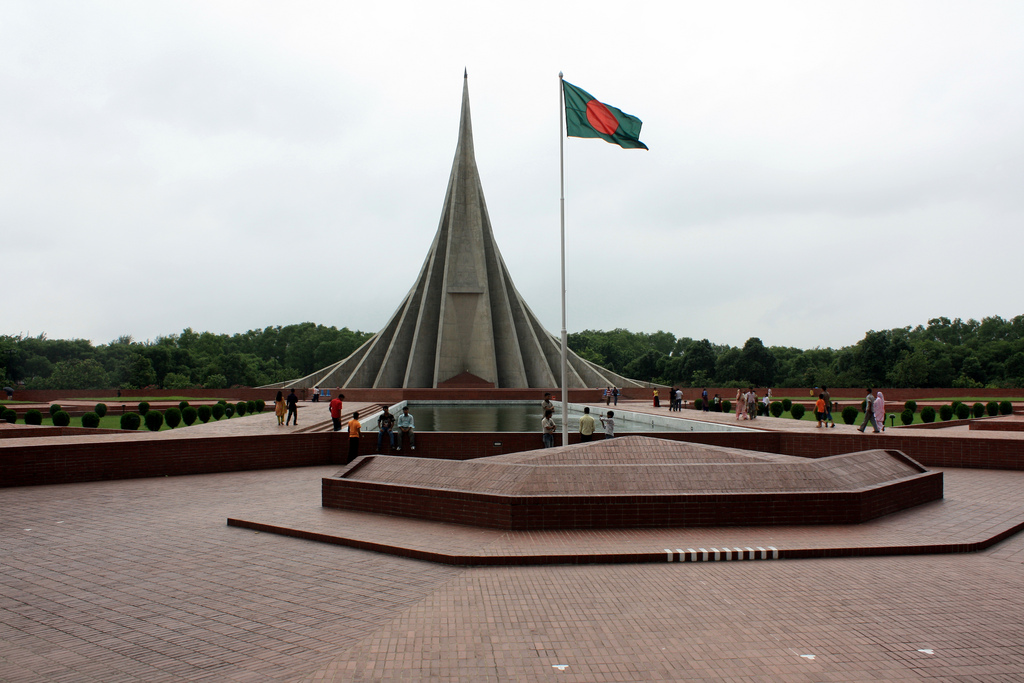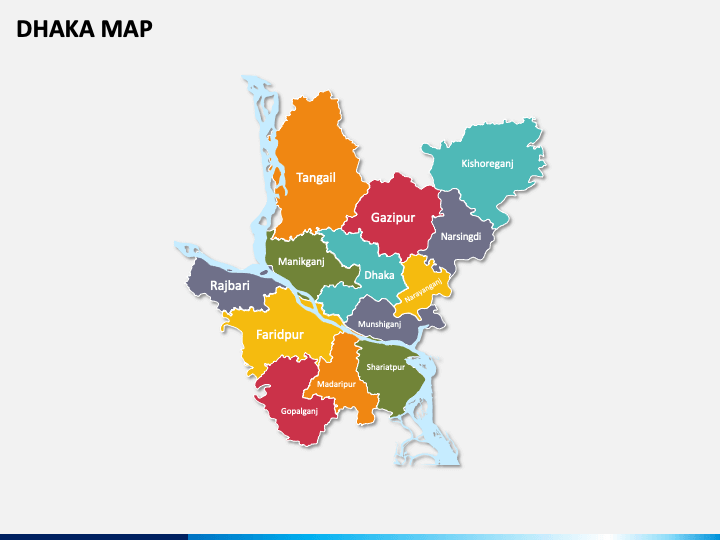Official Name Capital Language Population Religions Muslim 88.3%, Hindu 10.5%, others 1.2% |
Location Boundary Area Climate Rainfall
|
Principal Rivers Principal Crops
Fruits Major Industries |
PHYSICAL OVERVIEW
Most of the areas of Bangladesh lies within the broad delta formed by the Ganges and Brahmaputra rivers. Lands are exceedingly flat, low-lying, and subject to annual flooding. Much fertile, alluvial soil is deposited by the floodwaters. The only significant area of hilly terrain, constituting less than one-tenth of the nation's territory, is the Chittagong Hill Tracts in the narrow southeastern panhandle of the country. There, on the border with Burma, is Mowdok Mual (1003 m/3292 ft), the country's highest peak. Small, scattered hills lie along or near the eastern and northern borders with India. The eroded remnants of two old alluvial terraces-the Madhupur Tract, in the north central part of the country, and The Barind, straddling the northwestern boundary with India- attain elevations of about 30 m (about 100 ft). The soil here is much less fertile than the annually replenished alluvium of the surrounding floodplain.
Rivers and Lakes
Bangladesh is a land of rivers that crisscrossed throughout the mostly flat territories of the country. They include hundreds of brooks and a good number of big ones. The Ganges (Ganga) is known as the Padma below the point where it is joined by the Jamuna River, the name given to the lowermost portion of the main channel of the Brahmaputra. The combined stream is then called the Meghna below its confluence with a much smaller tributary of the same name. In the dry season the numerous deltaic distributaries that lace the terrain may be several kilometers wide as they near the Bay of Bengal, whereas at the height of the summer monsoon season they coalesce into an extremely broad expanse of silt-laden water. In much of the delta, therefore, homes must be constructed on earthen platforms or embankments high enough to remain above the level of all but the highest floods. In non-monsoon months the exposed ground is pocked with water-filled borrow pits, or tanks, from which the mud for the embankments was excavated. Throughout the country there are bils, haors and lakes that meet the need of drinking, bathing and irrigating water.
Seasons
Traditionally Bangladeshis subdivide the year into six seasons: Grismo (summer), Barsha (rainy), Sharat (autumn), Hemanto (cool), Sheet (winter), and Bashonto (spring). For practical purposes, however, three seasons are distinguishable: summer , rainy, and winter.
Climate
Bangladesh has a tropical monsoon-type climate, with a hot and rainy summer and a dry winter. January is the coolest month with temperatures averaging near 26 deg C (78 d F) and April the warmest with temperatures from 33 to 36 deg C (91 to 96 deg F). The climate is one of the wettest in the world. Most places receive more than 1,525 mm of rain a year, and areas near the hills receive 5,080 mm ). Most rains occur during the monsoon (June-September) and little in winter (November-February).
Bangladesh is subject to devastating cyclones, originating over the Bay of Bengal, in the periods of April to May and September to November. Often accompanied by surging waves, these storms can cause great damage and loss of life. The cyclone of November 1970, in which about 500,000 lives were lost in Bangladesh, was one of the worst natural disasters of the country in the 20th century.
HISTORY OF BANGLADESH

Bangladesh came to today's shape through a long history of political evolution. Bengal was probably the wealthiest part of the subcontinent up till the 16th century. The area's early history featured a succession of Indian empires, internal squabbling, and a tussle between Hinduism and Buddhism for dominance. All of this was just a prelude to the unstoppable tide of Islam which washed over northern India at the end of the 12th century. Mohammed Bakhtiar Khalzhi from Turkistan captured Bengal in 1199 with only 20 men.
Under the Mughal viceroys, art and literature flourished, overland trade expanded and Bengal was opened to world maritime trade - the latter marking the death knell of Mughal power as Europeans began to establish themselves in the region. The Portuguese arrived as early as the 15th century but were ousted in 1633 by local opposition. The East India Company negotiated terms to establish a fortified trading post in Calcutta in 1690.
The decline of Mughal power led to greater provincial autonomy, heralding the rise of the independent dynasty of the nawabs of Bengal. Humble East India Company clerk Robert Clive ended up effectively ruling Bengal when one of the impetuous nawabs attacked the thriving British enclave in Calcutta and stuffed those unlucky enough not to escape in an underground cellar. Clive retook Calcutta a year later and the British Government replaced the East India Company following the Indian Mutiny in 1857.
The Britons established an organizational and social structure unparalleled in Bengal, and Calcutta became one of the most important centers for commerce, education and culture in the subcontinent. However, many Bangladeshi historians blame the British dictatorial agricultural policies and promotion of the semi-feudal zamindar system for draining the region of its wealth and damaging its social fabric. The British presence was a relief to the minority Hindus but a catastrophe for the Muslims. The Hindus cooperated with the Brits, entering British educational institutions and studying the English language, but the Muslims refused to cooperate, and rioted whenever crops failed or another local product was rendered unprofitable by government policy. At the closure of World War II it was clear that European colonialism had run its course and Indian independence was inevitable. Independence was attained in 1947 but the struggle was bitter and divisive, especially in Bengal where the fight for self-government was complicated by internal religious conflict. The British, realizing any agreement between the Muslims and Hindus was impossible, decided to partition the subcontinent. That Bengal and Punjab, the two overwhelmingly Muslim regions, lay on opposite sides of India was only one stumbling block. The situation was complicated in Bengal where the major cash crop, jute, was produced in the Muslim-dominated east, but processed and shipped from the Hindu-dominated city of Calcutta in the west.
A Long Way to Freedom
The people of Bangladesh discovered their identity through the Language Movement in 1952. The struggle to establish their identity and national spirit began soon after 1947 when they realized that under Pakistan created on the two nation theory they was little scope for the distance culture of Banglees to flourish . The refusal of the central government to grant status to Bangla language became the focal point of struggle, because language was the most important vehicle of the cultural expression of the people of this land.
The contradiction of the two Pakistans , the racial oppression and the exploitation of the West over the East was gradually unveiled. The struggle for the consciousness of identity and cultural freedom which began with the advent of the student movements of the 60's gained momentum in the mass movement of 1969. Though it brought about the fall of a mighty military ruler like Ayub Khan, the ultimate goal was not achieved. After this, came the election of 1970 with absolute victory of Sheikh Mujibur Rahaman. In the elections of December 7, 1970 the Awami League won 160 out of 162 seats in East Pakistan, all but two, and would have had a clear majority in the new assembly had it been convened. Sheikh Mujibur Rahman became the majority party leader of the Pakistan National Assembly .
The military rules of Pakistan refused to allow the Awami League to form a government. Major General Ziaur Rahman on behalf of Mujib declared independence. A full scale movement of non-cooperation with the military government began on the 26th of March, 1971 which is celebrated as the Independence Day every year. Thus Bangladesh plunged into a civil war.
The Pakistan Army began their genocide by attacking the innocent Bangalees of Dhaka city. The dwellers of Dhaka city never confronted such intolerable days. The Pakistani army massacred 35,000 Bengali intellectuals and unleashed a brutal war against the Bangalees of East Pakistan to prevent their secession. But no one let the dream encircled flag fall down to dust .
During the nine month struggle which ensued an estimated three million Bengalis died and and ten million refuges fled into India Sheikh Mujib was imprisoned in west Pakistan. A Bangladesh Government in exile was established. The actual military campaign took place in December and lasted only ten days. The Indian Army launched a massive offensive against the Pakistani forces to support the Bangladesh movement . On December 16, 1971, the Pakistan army surrendered.
NATIONAL FLAG

The national flag of Bangladesh is bottle green in color and rectangular in size with the length to width ratio of 10:6. It bears a red circle on the background of green. The color in the background represents the greenery of Bangladesh while the red circle symbolizes the rising sun and the sacrifice of lives in our freedom fight. The national flag was designed by Kamrul Hasan.
Prescribed sizes of the flag for buildings are 305cm X 183cm, 152cm X 91cm and 76cm X 46cm and for vehicles are 38cm X 23cm and 25cm X 15cm. At the very outset the flag had a different look. There was a golden colored map of Bangladesh at the center of the red circle. This was the original design of the flag of Bangladesh under which the valiant freedom fighters fought during the liberation war.
CAPITAL

Dhaka is the capital and largest city of Bangladesh. Today's Dhaka has a long story of evolution. It was founded during the 10th century. It served as the Mughal capital of Bengal from 1608 to 1704.Before coming under British rule in 1765 it was a trading center for British, French, and Dutch colonialism. In 1905 it was again named the capital of Bengal, and in 1956 it became the capital of East Pakistan. During the Bangladesh war of independence in1971 the city suffered a heavy damage. In 1982 the spelling was changed from 'Dacca' to 'Dhaka'.
Dhaka is located in the geographic center of the country. It is in the great deltaic region of the Ganges and Brahmaputra rivers. The city is within the monsoon climate zone, with an annual average temperature of 25 deg C (77 deg F) and monthly means varying between 18 deg C (64 deg F) in January and 29 deg C (84 deg F) in August. Nearly 80% of the annual average rainfall of 1,854 mm (73 in) occurs between May and September.
PEOPLE
98 percent of the people of Bangladesh are Bangalees. The major religion is Muslim with 80 percent of total population. The second major religion is Hinduism which constitutes 16 percent. Other religions include Buddhism and Christianity. Minorities include Biharis and tribes. Among the tribes Chakma is the biggest.
Bangladesh is one of the largest Muslim countries in the world. Most Bangladeshi Muslims are Sunnis, but there is a small Shia community. Among religious festivals of Muslims Eidul Fitr, Eidul Azha, Eiday Miladunnabi, Muharram etc. are prominent . The contention that Bengali Muslims are all descended from lower-caste Hindus who were converted to Islam is incorrect; a substantial proportion are descendants of the Muslims who reached the subcontinent from elsewhere.
Hinduism is professed by about 12 percent of the population. Durga Puja, Saraswati Puja, Kali Puja etc. are Hindu festivals. Hindus in Bangladesh are almost evenly distributed in all regions, with concentrations in Khulna, Jessore, Dinajpur, Faridpur, and Barisal.
Tribal race constitutes less than 1 percent of the total population. They live in the Chittagong Hills and in the regions of Mymensingh, Sylhet, and Rajshahi. The majority of the tribal population live in rural areas. They differ in their social organization, marriage customs, birth and death rites, food, and other social customs from the people of the rest of the country. They speak Tibeto-Burman languages. In the mid-1980s, the percentage distribution of tribal population by religion was Hindu 24, Buddhist 44, Christian 13, and others 19.
Major tribes are the Chakmas, Maghs (or Marmas), Tipras, Murangs, Kukis and Santals. The tribes tend to intermingle and could be distinguished from one another more by differences in their dialect, dress, and customs than by tribal cohesion. Only the Chakmas and Marmas display formal tribal organization. They are of mixed origin but reflect more Bengali influence than any other tribe. Unlike the other tribes, the Chakmas and Marmas generally live in the highland valleys. Most Chakmas are Buddhists, but some practice Hinduism or Animism.
The Santals live in the northwestern part of Bangladesh. They obey a set of religious beliefs closely similar to Hinduism. The Khasais live in Sylhet in the Khasia Hills near the border with Assam, and the Garo and Hajang in the northeastern part of the country.
LANGUAGE
Bangla is the official language of Bangladesh. It is also spoken in West Bengal. Bangalees protected Bangla from the clutches of Pakistani oppressors in 1952 by preventing Urdu from being the state language of East Pakistan where a vast majority of people spoke in Bangla. Bangalees had to sacrifice lives for their mother tongue on 21st February, 1952. 21st February being declared International Mother Language Day by UNESCO, Bangla reached the peak of maturity.
ART AND CULTURE
Bangladesh is a melting pot of races. She, therefore, has a mixed culture. Her deep rooted heritage is amply reflected in her architecture, literature, dance, drama, music and painting. Bangladeshi culture is influenced by three great religions- Hinduism, Buddhism and Islam in successive order, with Islam having the most pervading and lasting impact. Like a colorful montage, the cultural tradition of the country is a happy blending of many variants, unique in diversity but in essencegreatly symmetrical.
Festivals
A series of festivals varying from race to race are observed here. Some of the Muslim rites are Eid-e-Miladunnabi, Eid-ul-Fitr, Eid-ul-Azha, Muharram etc. Hindus observe Durga Puja, Saraswati Puja, Kali Puja and many other pujas. Christmas ( popularly called Baradin in Bangla ) is observed by Christians. Also there are some common festivities, which are observed countrywide by people irrespective of races. Pahela Baishakh (the first day of Bangla year) is such a festival. National festivals are Independence Day (26th March), 21st February (the National Mourning Day and World Mother Language Day), The Victory Day (16th December), Rabindra & Nazrul Jayanti etc.
Literature
Bangalees have a rich literary heritage. The earliest available specimen of Bengali literature is about a thousand years old. During the mediaeval period. Bengali Literature developed considerably with the patronage of Muslim rulers. Chandi Das, Daulat Kazi and Alaol are some of the famous poets of the period. The era of modern Bengali Literature began in the late nineteenth century Rabindranath Tagore, the Nobel Laureate is a vital part of Bangalee culture. Kazi Nazrul Islam, Michael Madhusudan Datta. Sarat Chandra Chattopadhaya, Bankim Chandra Chattopadhaya, Mir Mosharraf Hossain and Kazi Ahdul Wadud are the pioneers of modern Bengali Literature.
Music
The traditional music in Bangladesh shares the perspectives of that of the Indian sub-continent. Music in Bangladesh can be divided into three distinct categories -classical, folk and modern. The classical music, both vocal and instrumental is rooted in the remote past of the sub-continent. Ustad Alauddin Khan and Ustad Ayet Ali Khan are two names in classical instrumental music who are internationally known.
The store of folk song abounds in spiritual lyrics of Lalan Shah, Hasan Raja, Romesh Shill and many anonymous lyricists. Bangla music arena is enriched with Jari, Shari, Bhatiali, Murshidi and other types of folk songs. Rabindra Sangeet and Nazrul Sangeet are Bangalees' precious heritage. Modern music is also practiced widely. Contemporary patterns have more inclinations to west. Pop song and band groups are also coming up mainly in Dhaka City.
Bangladesh has a good number of musical instruments originally of her own. Originally country musical instruments include, Banshi (bamboo flute), Dhole (wooden drums), Ektara (a single stringed instrument), Dotara (a four stringed instrument), Mandira (a pair of metal bawls used as rhythm instrument), Khanjani, Sharinda etc. Now-a-days western instruments such as Guitar, Drums, Saxophone, Synthesizer etc. are being used alongside country instruments.
Clothing
Bangladeshi women habitually wear Sarees. Jamdani was once world famous for its most artistic and expensive ornamental fabric. Moslin, a fine and artistic type of cloth was well-known worldwide. Naksi Kantha, embroidered quilted patchwork cloth produced by the village women, is still familiar in villages and towns simultaneously. A common hairstyle is Beni (twisted bun) that Bangalee women are fond of. Traditionally males wear Panjabis, Fatuas and Pajamas. Hindus wear Dhuty for religious purposes. Now-a-days common dresses of males are shirts and pants. Government and non-government organizations like Bangla Academy, Nazrul Institute, Bangladesh Shilpakala Academy, Fine arts Institute, Chhayanat etc. play significant role to flourish Bangladeshi art and culture providing encouragement in music, drama, dance, recitation, art etc. Many other cultural organizations are also popularizing Bangladeshi art and culture.
Religion
Bangladesh is one of the largest Muslim countries in the world. About 80 percent of Bangladeshis are Muslims. Most Bangladeshi Muslims are Sunnis, but there is a small Shia community. Hinduism constitutes about 12 percent of the population. Hindus in Bangladesh in the 1990s were almost evenly distributed in all regions, with concentrations in Khulna, Jessore, Dinajpur, Faridpur, and Barisal.
There are significant numbers of Buddhists and Christians in Bangladesh. In the Chittagong Hills, Buddhist tribes formed the majority of the population and their religion appeared to be a mixture of tribal cults and Buddhist doctrines. According to the 1981 census, there were approximately 600,000 Buddhists in Bangladesh, representing less than 1 percent of the population. In the 1990s, Christianity had about 600,000 adherents, mainly Roman Catholic, and their numbers were growing rapidly.
(Ref: Bangladesh Parjatan Corporation, National Web Potal of Bangladesh, Bangladesh Bureau of Statistics, Wikipedia etc.)


